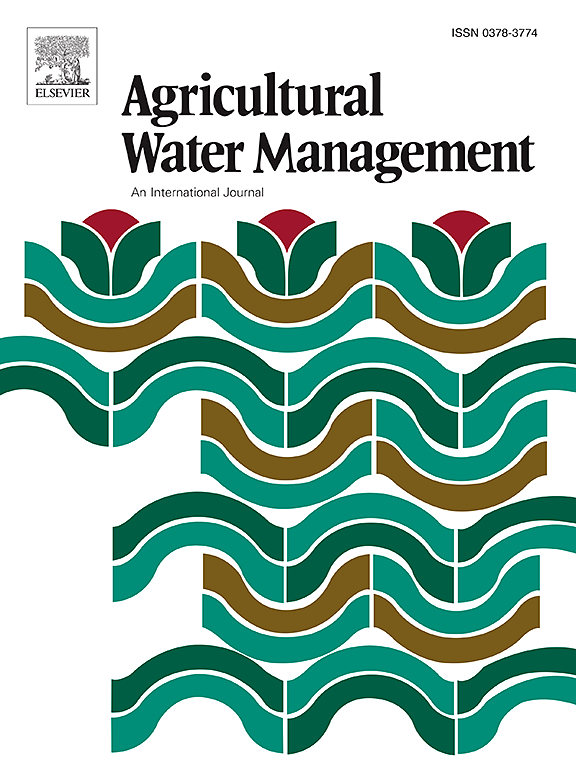Assessing the use of remotely sensed surface water flux to estimate net groundwater storage change in an aquifer predominantly used for irrigation
IF 5.9
1区 农林科学
Q1 AGRONOMY
引用次数: 0
Abstract
In intensely irrigated regions, effective cultivation and water use monitoring is crucial to ensure sustainability. Using the Steenkoppies Dolomitic Compartment (South Africa) as a case study, this study proposed a novel approach to monitor active cultivation, crop and net irrigation water use, and net groundwater storage (GWS) changes. The method addresses the limitations of annual land use land cover datasets and reliance on local ground-based data, enabling higher spatio-temporal Earth observation monitoring for intensively irrigated, groundwater-dependent areas. Remotely sensed data can estimate actual evapotranspiration (ETa) across various land cover types, but application for crop and irrigation water use monitoring specifically, requires integration with datasets identifying actively cultivated areas. A Random Forest classifier, trained on seasonal Sentinel-2 composites to capture crop phenological changes, was used to identify cultivated areas in monthly composites. These cultivated areas were integrated with WaPOR (Water Productivity Open Access Portal) ETa data to estimate monthly crop water use, while the difference between ETa and precipitation provided estimates of monthly surface water flux and net irrigation water use. Comparing surface water flux with net GWS changes offered a holistic, near real-time view of water demand and aquifer status at a monthly temporal resolution and a spatial resolution of 250 m. The study concluded that the irrigated cropped area expanded by 14 % since 2012, reaching 6 065 ha in 2021. The WaPOR-based crop water use estimates concluded a 250–300 mm shortfall compared to crop model estimates. The deficits between mean annual precipitation (652–733 mm yr−1) and the WaPOR-based mean annual irrigated crop water use (1 090 mm yr−1) over 6 065 ha equate to 21.7 Mm³ yr−1 and 26.6 Mm³ yr−1, aligning with the literature groundwater abstraction estimates exceeding 20 Mm³ for irrigation. Using the pixel-based, sum of monthly net irrigation estimates, however, even when factoring in a precipitation efficiency of 70 % and an irrigation efficiency of 80 %, the WaPOR-based net irrigation water use was estimated at only 12.7 Mm³ yr−1 for 2018/19 and 9.3 Mm³ yr−1 for 2019/20. The comparison of surface water flux with net GWS and precipitation confirmed that irrigated cultivation is the primary groundwater user, and that groundwater abstraction peaks during low precipitation periods, with precipitation being the main aquifer recharge source. Surface water flux proved a reliable proxy for monitoring and predicting the impact of irrigation on GWS levels during dry seasons. The cultivation and net irrigation intensity maps can be essential for strategising regulatory efforts and monitoring compliance with groundwater mitigation measures.
评估利用遥感地表水通量来估计主要用于灌溉的含水层的地下水净储量变化
在密集灌溉地区,有效的种植和用水监测对确保可持续性至关重要。本研究以南非Steenkoppies白云岩隔层为例,提出了一种监测主动耕作、作物和净灌溉用水以及净地下水储水量变化的新方法。该方法解决了年度土地利用、土地覆盖数据集的局限性和对当地地面数据的依赖,为密集灌溉、地下水依赖地区提供了更高的时空地球观测监测。遥感数据可以估算不同土地覆盖类型的实际蒸散量(ETa),但具体应用于作物和灌溉用水监测,需要与识别活跃耕地的数据集集成。随机森林分类器经过季节性Sentinel-2复合材料的训练,捕捉作物物候变化,用于识别月度复合材料中的耕地面积。这些耕地与WaPOR(水生产力开放获取门户网站)ETa数据相结合,以估计每月作物用水量,而ETa与降水之间的差异提供了每月地表水通量和净灌溉用水量的估算。将地表水通量与净GWS变化进行比较,可以以每月时间分辨率和250 m的空间分辨率全面、近实时地了解水需求和含水层状况。该研究得出结论,自2012年以来,灌溉作物面积扩大了14% %,到2021年达到6065 公顷。基于wapor的作物用水量估计值与作物模型估计值相比减少了250-300 毫米。平均年降水量(652-733 mm yr−1)与基于wapor的灌溉作物年平均用水量(1 090 mm yr−1)之间的差额大于6065 ha,等于21.7 mm³ yr−1和26.6 mm³ yr−1,与文献中超过20 mm³ 的灌溉地下水提取估算值一致。然而,使用基于像素的月度净灌溉估计值,即使考虑到降水效率为70% %和灌溉效率为80% %,基于wapor的净灌溉用水量在2018/19年和2019/20年分别仅为12.7 Mm³ yr - 1和9.3 Mm³ yr - 1。地表水通量与净GWS和降水的比较证实,灌溉灌溉是地下水的主要用户,在降水少的时期,地下水抽取量达到峰值,降水是含水层补给的主要来源。地表水通量被证明是监测和预测干旱季节灌溉对GWS水平影响的可靠指标。种植和净灌溉强度图对于制定管理工作战略和监测地下水缓解措施的遵守情况至关重要。
本文章由计算机程序翻译,如有差异,请以英文原文为准。
求助全文
约1分钟内获得全文
求助全文
来源期刊

Agricultural Water Management
农林科学-农艺学
CiteScore
12.10
自引率
14.90%
发文量
648
审稿时长
4.9 months
期刊介绍:
Agricultural Water Management publishes papers of international significance relating to the science, economics, and policy of agricultural water management. In all cases, manuscripts must address implications and provide insight regarding agricultural water management.
 求助内容:
求助内容: 应助结果提醒方式:
应助结果提醒方式:


